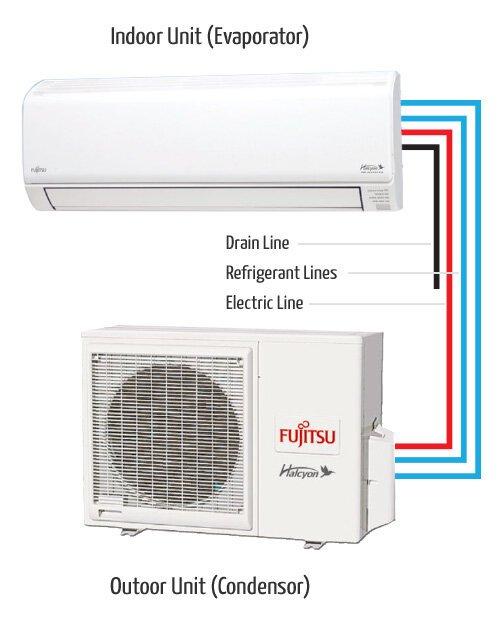Revolutionizing Home Comfort: The Future of Energy-Efficient Air Conditioning
As the summer sun blazes longer and hotter, the need for a cool refuge within our homes becomes increasingly urgent. This often results in skyrocketing energy expenses and a heavier dependence on traditional cooling methods. Fortunately, an exciting evolution in air conditioning technology is emerging, set to transform our energy consumption habits while keeping us comfortable. In this article, we will explore cutting-edge air conditioning innovations that not only provide relief from oppressive heat but also significantly lower energy costs. With breakthroughs in design, materials, and smart technology integration, these systems are leading us toward a more sustainable future—offering both financial savings for consumers and benefits for the environment. Join us as we examine the latest advancements highlighted by CleanTechnica and uncover how these groundbreaking solutions are reshaping modern cooling.
Cutting-Edge Technologies Transforming Air Conditioning
The recent surge in air conditioning innovations is redefining climate control standards. Intelligent thermostats now employ artificial intelligence to adapt to user preferences dynamically, optimizing temperature settings to enhance comfort while reducing energy expenditure. Furthermore, variable refrigerant flow (VRF) systems allow different areas of a building to be cooled or heated independently—ensuring that no energy is wasted on unoccupied spaces. These advancements contribute significantly to lowering overall energy usage while positively impacting both costs and environmental sustainability.
Additionally, new refrigerants engineered for improved efficiency with reduced global warming potential are gaining popularity within the industry. Alternatives such as hydrofluoroolefins (HFOs), along with natural options like ammonia and CO2, offer promising substitutes for conventional refrigerants. Coupled with innovative designs like magnetocaloric cooling, which utilizes magnetic fields for effective temperature management, these technologies herald a future characterized by enhanced energy savings. Below is an overview of their impacts:
| Technology Type | Efficiency Gains | Sustainability Impact |
|---|---|---|
| Smart Thermostats | Around 30% reduction in energy use | Lowers carbon emissions significantly |
| VRF Systems | An increase of 20-40% efficiency levels | Dramatically reduces unnecessary power waste |
| Magnetocaloric Cooling td > | Potentially cuts down on 50% of power usage td > | No risk of ozone layer depletion td > |
Understanding the Environmental Advantages of Modern Cooling Solutions
The rise of advanced cooling technologies presents environmentally friendly alternatives that not only curtail electricity consumption but also help reduce carbon footprints substantially. By leveraging state-of-the-art solutions such as variable refrigerant flow systems alongside intelligent thermostats, users can achieve optimal efficiency without sacrificing reliable cooling capabilities. Implementing these systems allows individuals to experience significant decreases in greenhouse gas emissions—positioning them as crucial contributors in combating climate change.
- Energized Efficiency: Advanced technologies effectively manage electricity use.
- Cleansed Air Quality: Reduced reliance on fossil fuels leads to improved air quality.
- Sustainable Water Use:No or minimal water requirements conserve this vital resource.
The lifecycle approach adopted by modern cooling solutions prioritizes sustainability at every stage—from production through disposal—encouraging manufacturers to utilize recyclable materials while minimizing harmful refrigerants’ presence—all contributing positively towards ecosystem health.
As adoption rates increase globally across various sectors—the potential impact regarding worldwide energy conservation becomes strikingly clear.
To illustrate this further consider comparisons below:
| Cooling Technology Type | EER Rating | Plausible Annual Energy Savings |
|---|---|---|
| Conventional AC System | 10 .0 | Baseline (0%) |
Tips For Homeowners To Enhance Energy Efficiency And Save Costs!
This summer season brings challenges when trying keep your home comfortably cool without breaking bank accounts! Adopting efficient practices plays pivotal role here! Regular upkeep maintenance checks should be performed regularly; cleaning/replacing filters monthly enhances airflow & boosts system performance! Consider investing into programmable thermostat devices allowing you set temperatures based upon daily schedules thus drastically cutting down unnecessary expenditures during times when nobody’s around! Another effective method involves sealing ducts/windows preventing drafts ensuring chilled indoor atmosphere remains intact! p >
Additionally incorporating high-efficiency appliances can yield substantial cost reductions over time; look out specifically ENERGY STAR certified products meeting strict guidelines regarding operational efficiencies!
To further optimize living conditions consider utilizing strategically placed fans circulating cooler breezes evenly throughout spaces making them feel more pleasant overall!
Don’t overlook importance insulation either; improving attic/wall insulation could greatly lessen reliance upon AC units altogether resulting refreshing indoor environments whilst being budget-friendly too! p >
Conclusion: Embracing A Sustainable Future Through Innovative Cooling Solutions!
The emergence super-efficient air conditioning technologies signifies remarkable progress towards achieving sustainable approaches addressing pressing issues surrounding climate change rising utility bills alike!
By embracing innovative developments available today individuals businesses alike have opportunity play integral roles reducing overall consumption fostering greener planet paving pathways towards brighter tomorrow ahead!
As we advance forward possibilities remain just as invigorating refreshing breeze provided through efficient systems ushering forth new era conscious living where staying cool doesn’t come at expense environment nor wallets alike!
Let’s commit ourselves together creating cleaner healthier world one breath fresh air time!
